Winter birding often has a bad reputation. It’s cold. Birds can be hard to find. And many birders are longing for the variety that spring migration brings.
But I love winter birding. You get to sleep in later. Leafless branches make birds easier to spot. And it’s a chance to seek out winter-only species that aren’t found in your area during the warmer months.
Winter also brings with it Audubon’s annual Christmas Bird Count, which runs from December 14 to January 5 each year. For the uninitiated, the Christmas Bird Count (or CBC for short) started in 1900, when American conservationists encouraged people to count birds, instead of shooting them. More than 120 years later, the CBC is still going strong in more than 20 countries.
Here we share 10 North American birds whose range changes dramatically in winter, making them the perfect species to search for during this year’s CBC. So if you need a break from holiday parties or bickering relatives, or want to spend time in nature to soothe frayed nerves, get out and bird.
This page will tell you everything you need to know about joining a CBC count near you. (The data collected on the CBC is used to help monitor bird populations, so there are some rules to ensure a consistent methodology across years.) And if these 10 species aren’t enough, check out our other list of 10 great snow birds to spot in winter.
A note on geography: Next to each species name, we’re providing a rough geographic guide on where to find each bird. For more detailed range maps, click on each bird’s name to see their profile on the Cornell Lab of Ornithology’s All About Birds resource.
-
Pine Siskin
Winter Range: Lower 48 (except Florida)
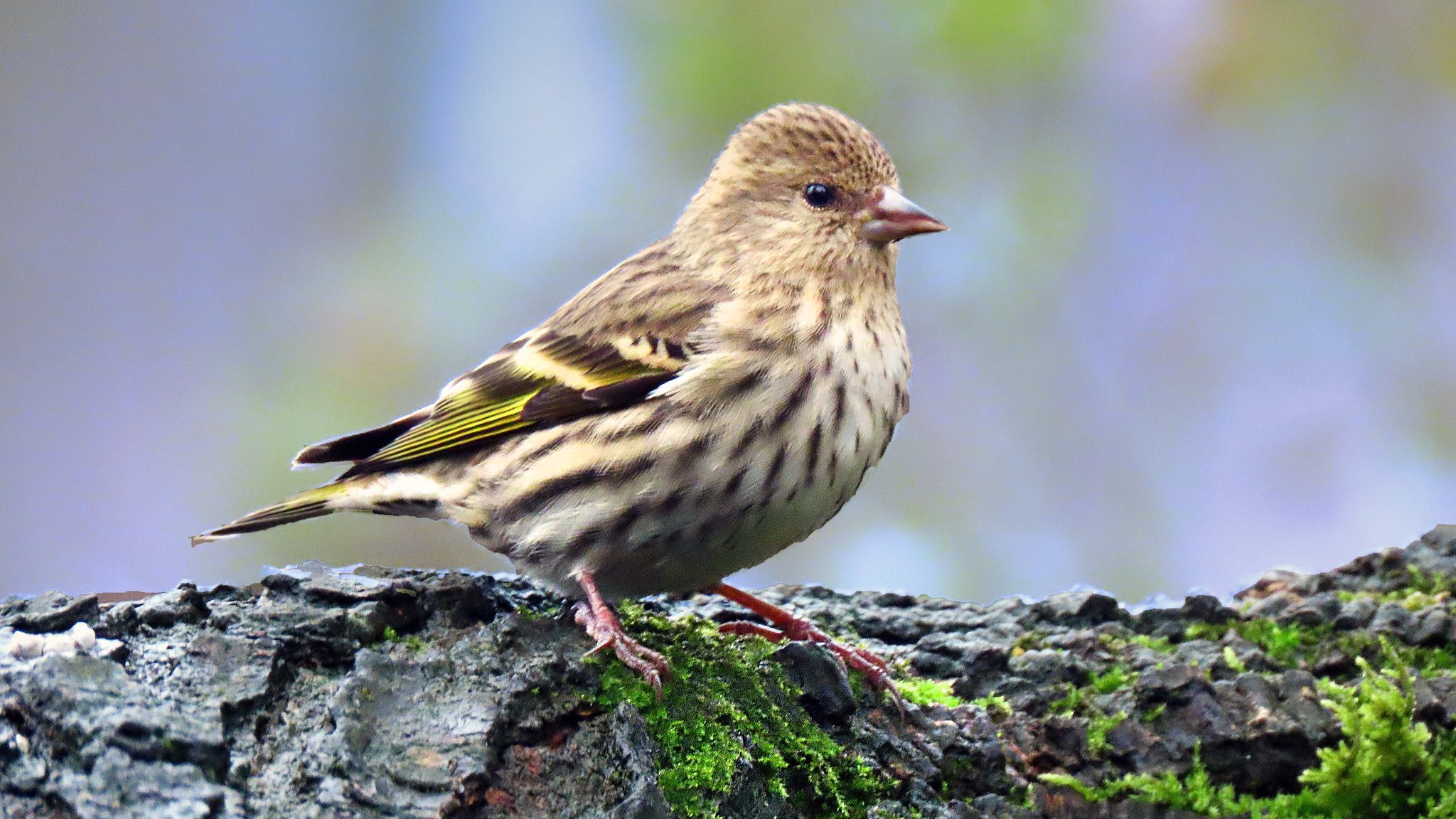
A pine siskin. © Richard Griffin / Flickr Small and streaky, pine siskins could easily be mistaken for another sparrow. But these acrobatic birds are actually a type of finch. Found year-round in part of the mountainous west, they irrupt in flocks across the rest of the country in winter, following seed crops.
Look for flocks of sparrow-sized birds with a diagnostic yellow tint to their primary feathers (the long feather on their wings) and tail. True to their name, they are often found near conifers, dangling from branch ends to feed on pine cone seeds. They will also feed at backyard feeders.
Pine siskins are irruptive, so seeing them one winter doesn’t guarantee they’ll be back the next. They’re also considered a common bird species in steep decline by The Partners In Flight, which estimates that pine siskin populations have declined by 80% since 1970.
-
Rough-legged Hawk
Winter Range: Lower 48, except parts of the Southeast

A juvenile rough-legged Hawk. © Ken Salzman / TNC The rough-legged hawk is one cool buteo. I have fond memories of shivering with cold as I searched for this uncommon species on the back roads near the Denver airport.
Rough-legged hawks spend their summers devouring lemmings on the Arctic tundra, and then migrate south to spend the winter in the continental US. Search for them in open areas — grasslands, fields, and agricultural areas — where they will often perch on telephone poles to search for prey.
They resemble red-tailed hawks in size and shape, with broad, fingered wings and a medium-length, wedge tail. Like red-tailed hawks, they have several color morphs, making identification especially tricky. I’d recommend checking out the Cornell Lab’s similar species page for more ID tips, and sitting down for a serious study session before birding. This is one bird where doing your homework will pay off.
Here are some quick tips: Red-tailed hawks often have dark leading edges to their wings (think shoulders) while rough-legged hawks often have dark patches before their wingtips (think wrists). All adult color morphs of the rough-legged hawk have dark wing tips (think fingers), a dark trailing edge (back of the wing), and a dark band across the tip of a white tail. Some birds have dark, brown-black plumage along their bodies, while others have streaky plumage with just a dark belly patch.
-
Northern Saw-whet Owl
Winter Range: Lower 48, especially the top-half
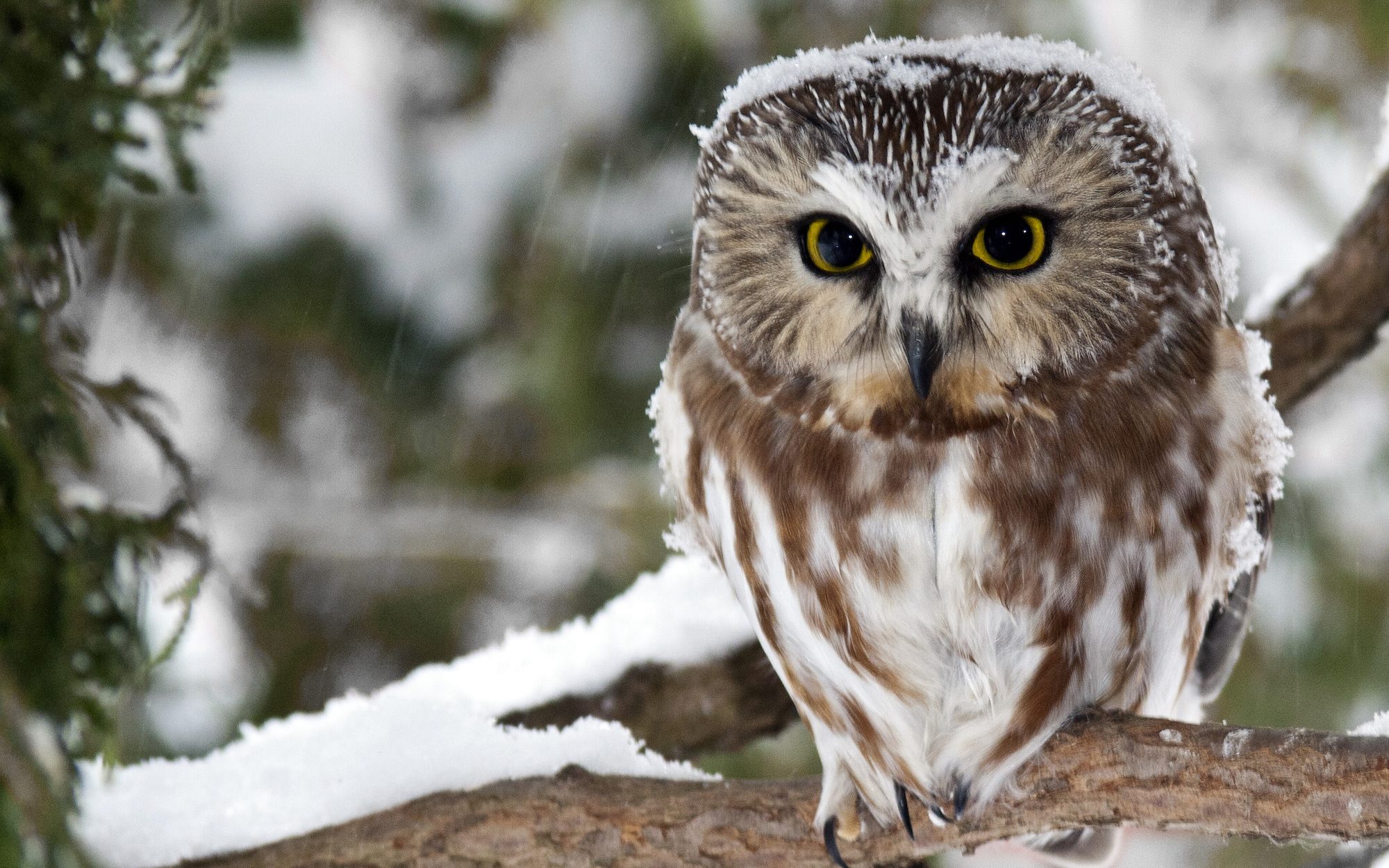
Northern Saw -Whet Owl in Montpelier, Vermont. © James D. Thompson / TNC Owling for any species is hard. And northern saw-whet owls are a tricky species to find. They’re quite small, just 8 inches long, with large, amber eyes and a distinctive, white, Y-shaped eyebrows. By day they roost in dense conifer trees, and at night they hunt the forest for small mammals, especially mice.
Birders often find them by watching other songbirds, who will harass sleeping owls. (I’ve also found this a useful technique to locate snakes. If the birds are freaking out, pay attention.) If you can’t see a northern saw-whet, you might be able to hear one. The Cornell Lab describes their call as a “sharp, high, repeated too-too-too,” and adults are especially vocal from January to May.
-
Northern Shrike
Winter Range: New England, North-central, and Northwest down to Colorado.

A northern shrike. © Mick Thompson / Flickr The northern shrike is a tiny but fearsome killer. This species, and the similar loggerhead shrike, regularly impales prey — often still alive — on spikes, thorns, or barbed wire, and leaves them there for days or weeks. (Read this story to learn more about the fascinating story behind shrikes and their grisly table manners.)
Northern shrikes breed in the high arctic and then migrate to the northern US for the winter months. Their winter range partially overlaps with the similar loggerhead shrike, so it’s a good idea to study your field guide before searching for this bird. The best way to tell them apart is the thickness of their black mask: loggerheads have a thicker line that wraps on top of their eye and across the top of their bill, while northern shrikes have a thinner black line that cut through their eye and weakens between the eye and bill. Northern shrikes also have narrow, white markings around their eye.
-
Purple Finch
Winter Range: Central, Northeast & Southeast, and coastal West
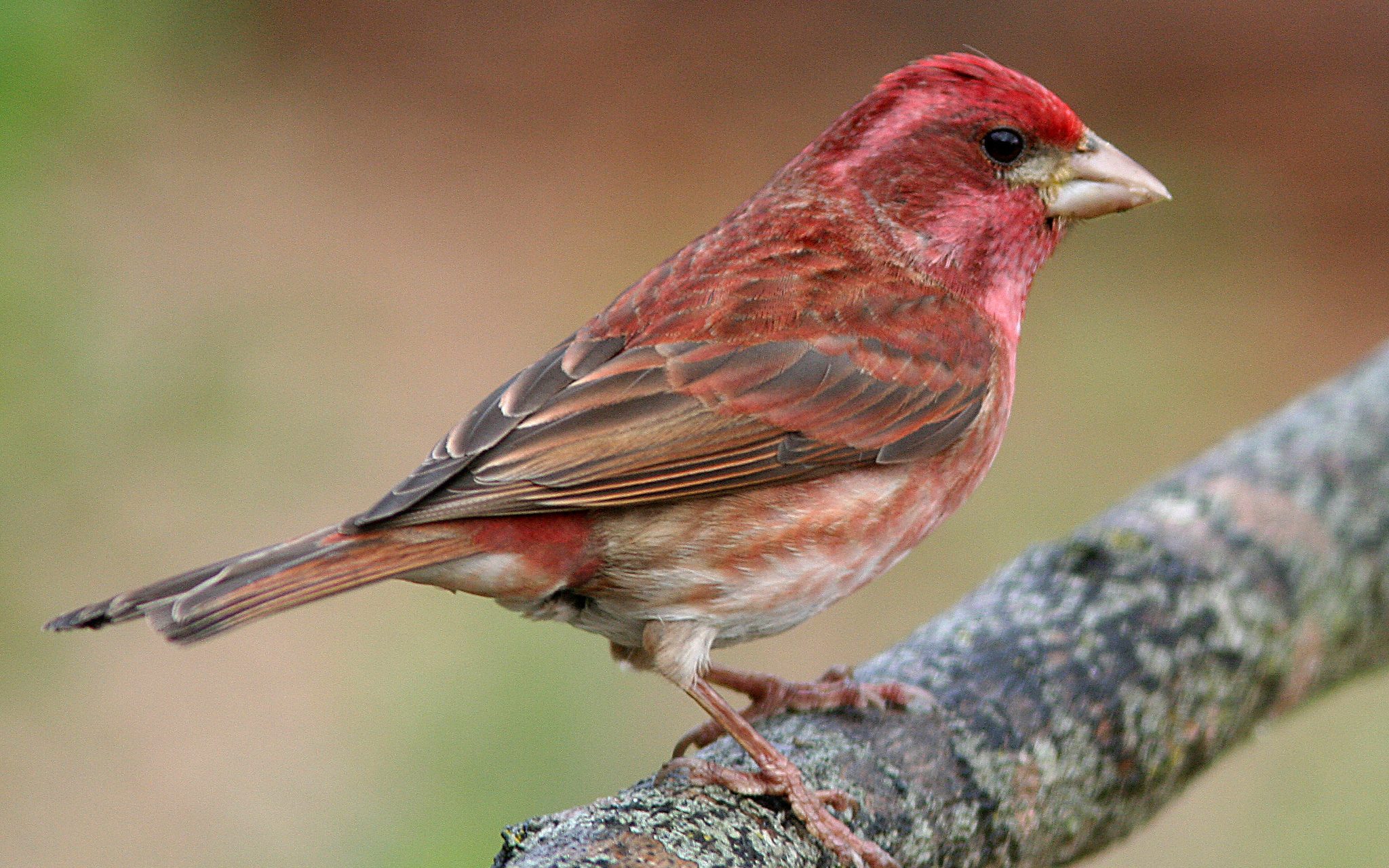
A purple finch. © Alan Schmierer / Flickr Famed bird illustrator Roger Tory Peterson described the purple finch as a “sparrow dipped in raspberry juice.” And he wasn’t wrong. Male purple finches have a deep reddish-purple hue across their head, breast, and back.
When birding, keep in mind that male house finches are very similar. Look for the purple-tinged feathers on a purple finch’s back, along with more color on the bird’s head. Cassin’s finches are also similar, although their ranges only overlap in the Pacific states.
Purple finches are found year-round in New England and along the Pacific coast, but during winter they migrate to the eastern and central US states (except peninsular Florida). They’re often spotted at backyard feeders, where they prefer sunflower seeds. Like the pine siskin they’re erratic, meaning they follow food resources and don’t reliably turn up in the same locations each year.
-
Golden-crowned & Ruby-crowned Kinglets
Winter Range: Lower 48 (golden) & Mountain west, South-central and Southeast (ruby)
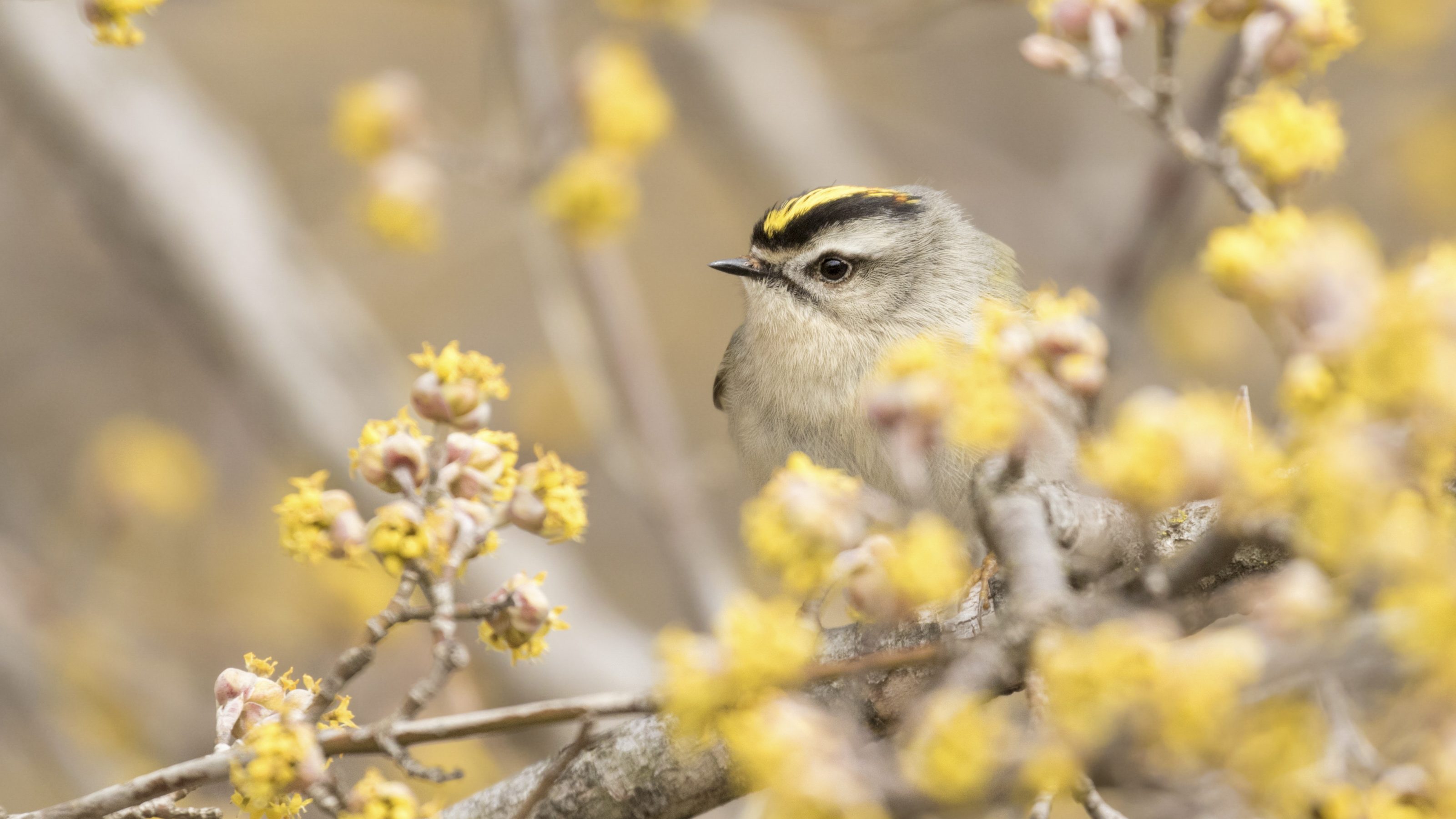
A golden-crowned kinglet emerges from branches of a flowering Cornellian cherry. © Loren Merrill / TNC Photo Contest 2019 If you’ve never seen a kinglet, think of a warbler but with an added surprise. Each species is named for the color of its feathered crest, either a golden yellow or fiery red.
The golden-crowned kinglet is usually found high in the canopy, where they’re very difficult to see. They have a visible steak of golden-orange feathers on the top of their heads, outlined on either side by a black band. They often forage with other species — including warblers, creepers, and chickadees — and will respond to pishing sounds.
Unlike the golden-crowned kinglet, the ruby-crowned kinglet’s crest is usually hidden out of view, tucked down amid the rest of their grey-brown plumage. Males will flash their crest when excited or singing, but other than that you’re not likely to spot it. The good news is that ruby-crowned kinglets usually forage in the understory, on low tree branches or surrounding shrubs, making them easier to see. Another good ID tip: ruby-crowned kinglets tend to flick their wings as they forage.
-
Ferruginous Hawk
Winter Range: Southwest
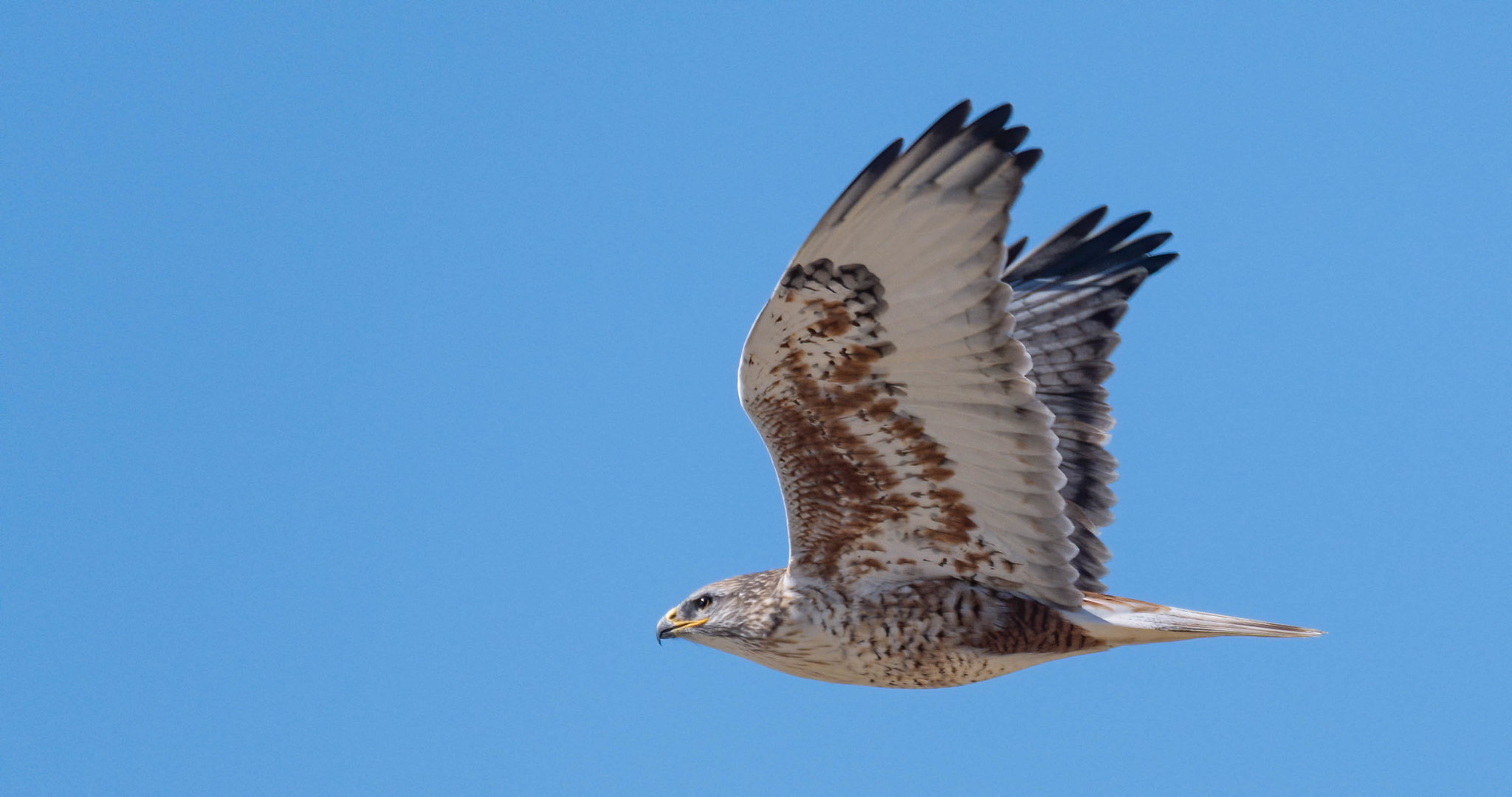
A flying ferruginous hawk. © Wendy Miller / Flickr Buteo identification can often be a headache, but the ferruginous hawk has distinctive white and russet plumage. Seen from below, their plumage is a creamy white, with rust-colored (or ferruginous!) feathers along their shoulders. They also have white tails and darkish tips to their primary feathers (think fingers). When perched, look for slate-gray and rufous feathers on the tops of their wings.
As with all buteos, there are color morphs. Dark-morph ferruginous hawks still have white flight and tail feathers, combined with chocolate brown bodies and heads. Another good identification tip: both rough-legged and ferruginous hawks have feathers all the way down their legs, to their toes. Compared to other buteos, like the red-tailed hawk, ferruginous hawks have more pointed and narrow wings and tend to fly with a dihedral V-shape.
Look for ferruginous hawks in open areas, like plains, prairies, and deserts. They will perch on telephone poles and stand on the ground to hunt. Another hint: stake out prairie dog towns, where groups of up to 10 hawks will congregate to stake out the burrows, and squabble over prey.
-
Winter Wren
Winter Range: Southeast & Central

A winter wren. © Fyn Kynd / Flickr The winter wren (Troglodytes hiemalis) is the smallest and darkest-colored wren in its range. It also has a very, short tail, even for a wren, which it holds straight and upright. Winter wrens spend summers in New England and Canada, and then migrate to the south-eastern US in winter. (They’re also found year-round in a narrow band across Appalachia.)
Look for them foraging near the ground in damp, shady areas, like pine forests and along streams. They often bounce through the undergrowth, hopping and scampering as they forage for insects.
If a winter wren is singing, you’ll often hear the bird before you see it. The Sibley Guide describes their call as “a remarkable kong series of very high, tinkling trills and warbles.” According to the Cornell Lab, winter wrens sing their song with 10 times more power than a crowing rooster, per unit of weight. That’s a lot of song for a bird that only weighs between .3 and .4 ounces.
-
Long-eared Owl
Winter Range: West, Northeast & possibly Southeast
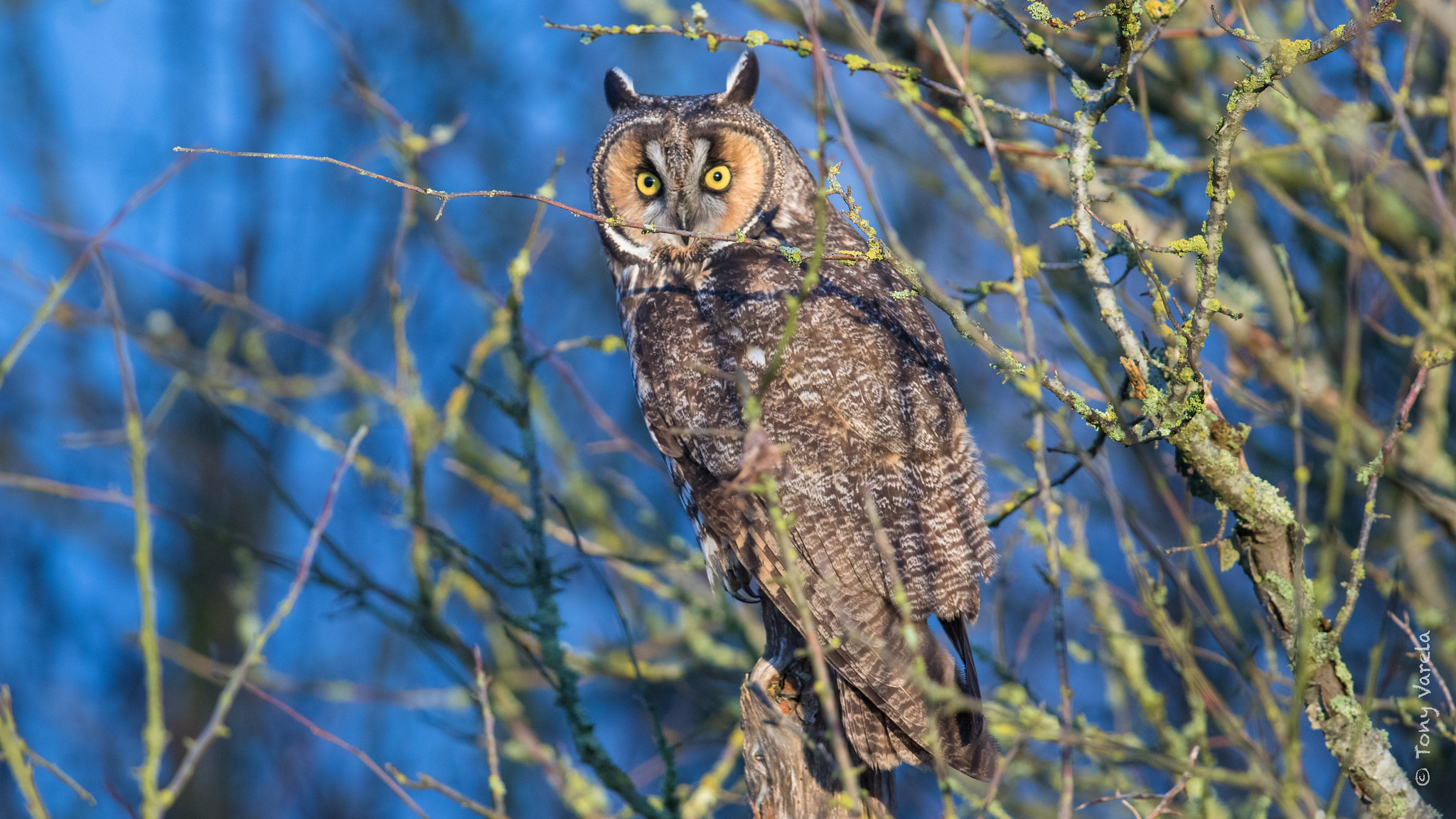
A long-eared owl. © Tony Varela Photography / Flickr The long-eared owl looks remarkably like a great horned owl, with a few key differences. Both species have mottled brown-gray plumage and a reddish facial disk. But the long-eared owl has a more slender, elongated body shape, while the great horned owl is larger and more chunky. Another key feature is the shape of their face: long-eared owls have a square-shaped face, as tall as it is wide, while great horned owl faces are more squashed and are noticeably wider than they are tall.
By day, long-eared owls roost in dense foliage, and by night they hunt small mammals in open country. Long-eared owls are notoriously tricky to find, as their mottled plumage provides excellent camouflage and they like to roost close to the trunk, where their silhouette is less likely to stand out. Look for them in dense tree stands, like pines or wind-breaks, near fields. Don’t forget to at the forest floor for pellets, which can also be a clue that an owl regularly roosts nearby.
-
Short-eared Owl
Winter Range: Lower 48
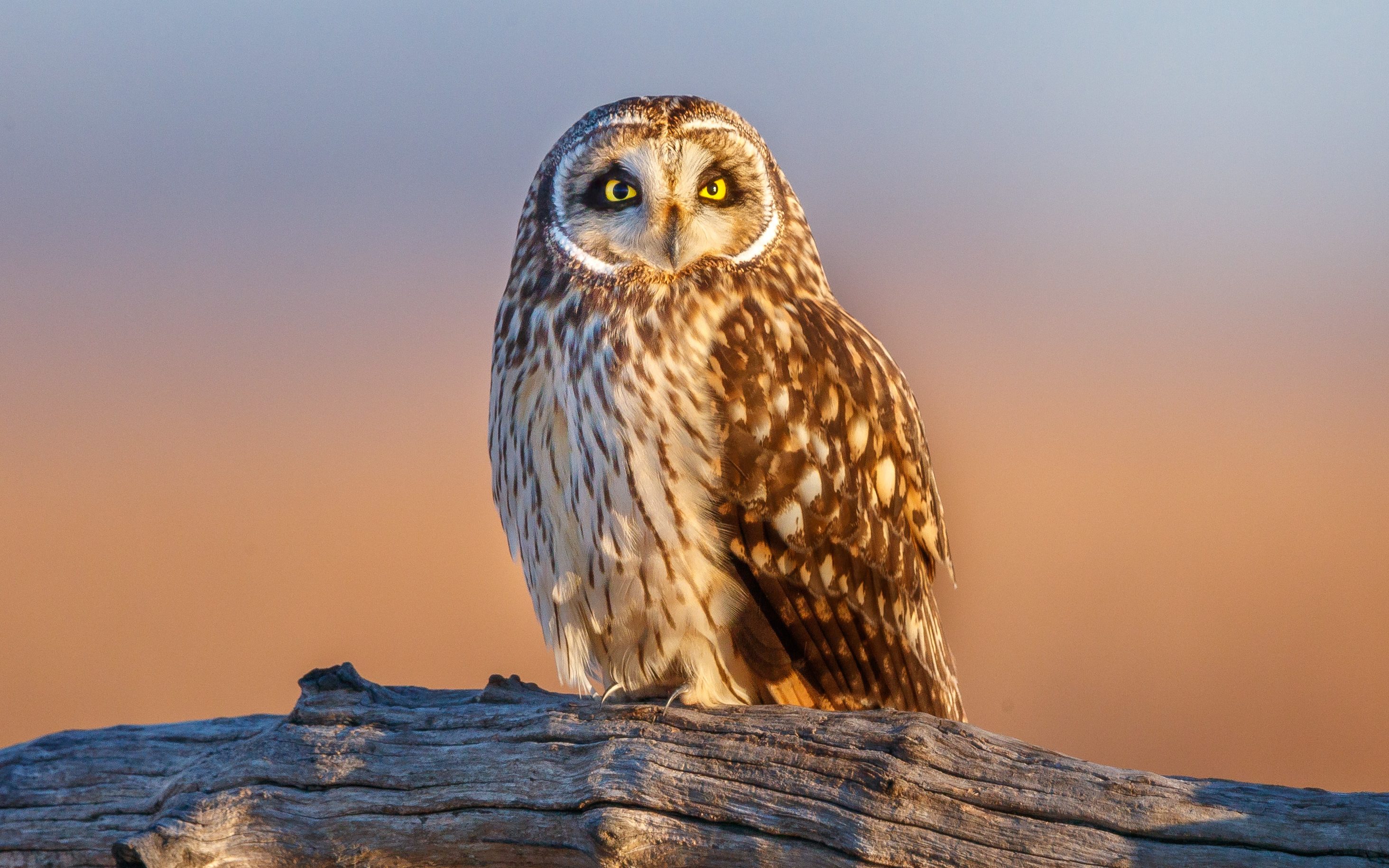
A short-eared owl at sunrise, Bombay Hook National Wildlife Refuge, Smyrna, Delaware, United States. © Jerry am Ende/TNC Photo Contest 2018 And now for the short-eared owl, whose ear tufts are so short that they’re usually not visible. According to the Cornell Lab, this species is one of the world’s most widely distributed owls, and one of the most commonly seen during the day. Look for distinctive, black-rimmed yellow eyes which contrast against the bird’s white facial disk.
To find this species, search open country — fields, farms, airports, or marshes — near dawn or dusk. They tend to perch on the ground or fly very low as they hunt, like a harrier.
Two fun facts about short-eared owls: If they’re disturbed on the nest, female short-eared owls will often defecate on their eggs before they flush. (Pun intended.) This behavior might dissuade any would-be predators from eating the eggs.
This species is also renowned for being able to fly for long distances, including over water. Multiple sources note reports of short-eared owls landing on boats far out to sea, including this story of a bird colliding with a boat off the coast of England.
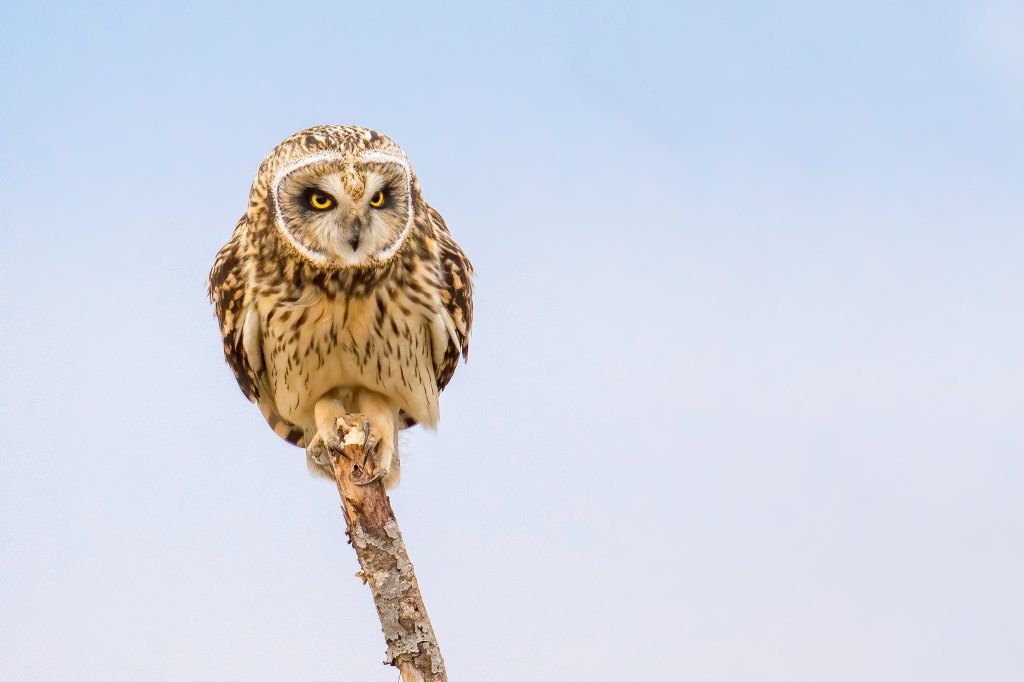



Very Nice Pictures of Birds